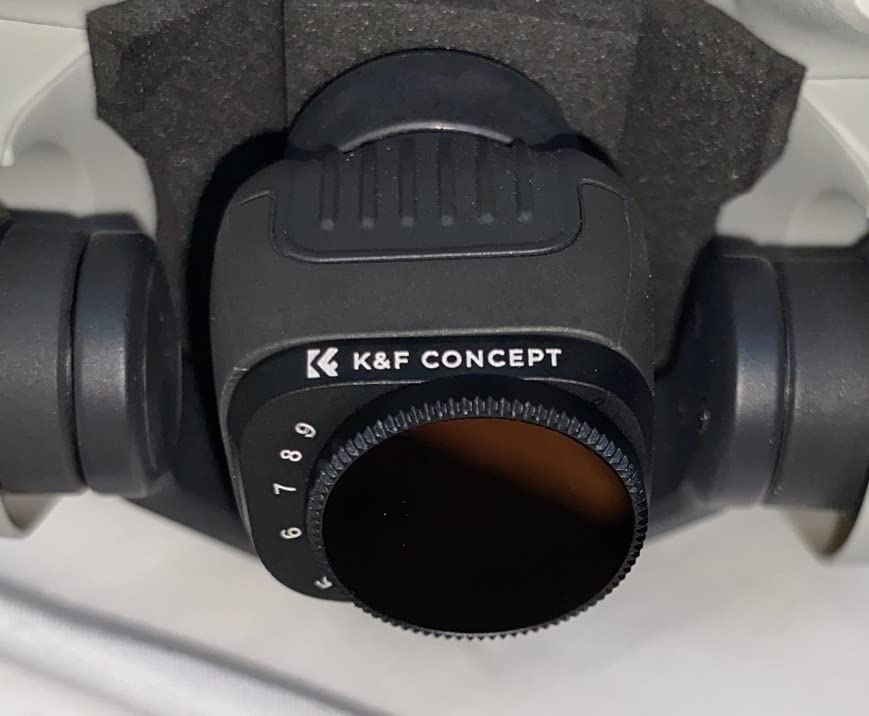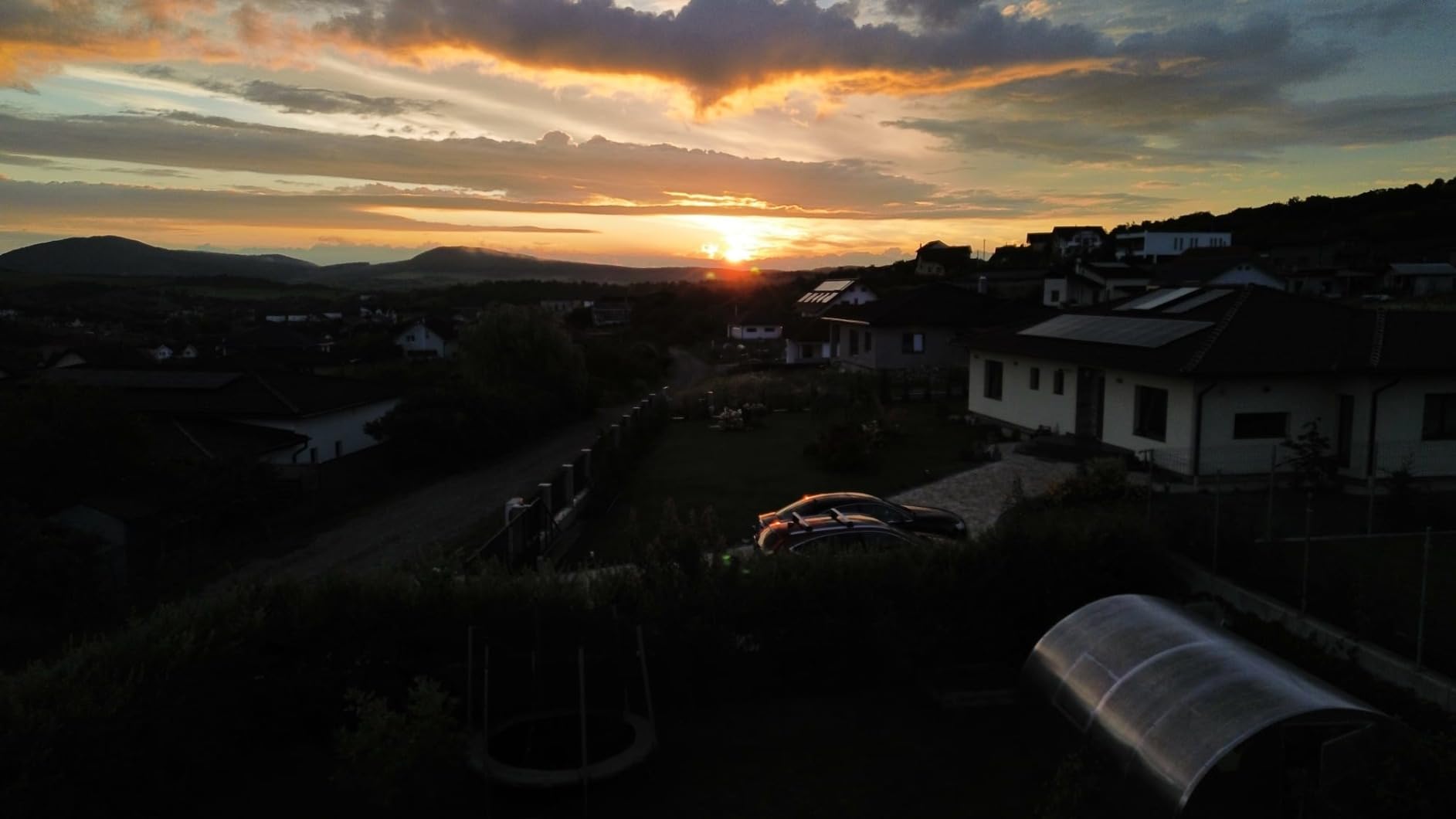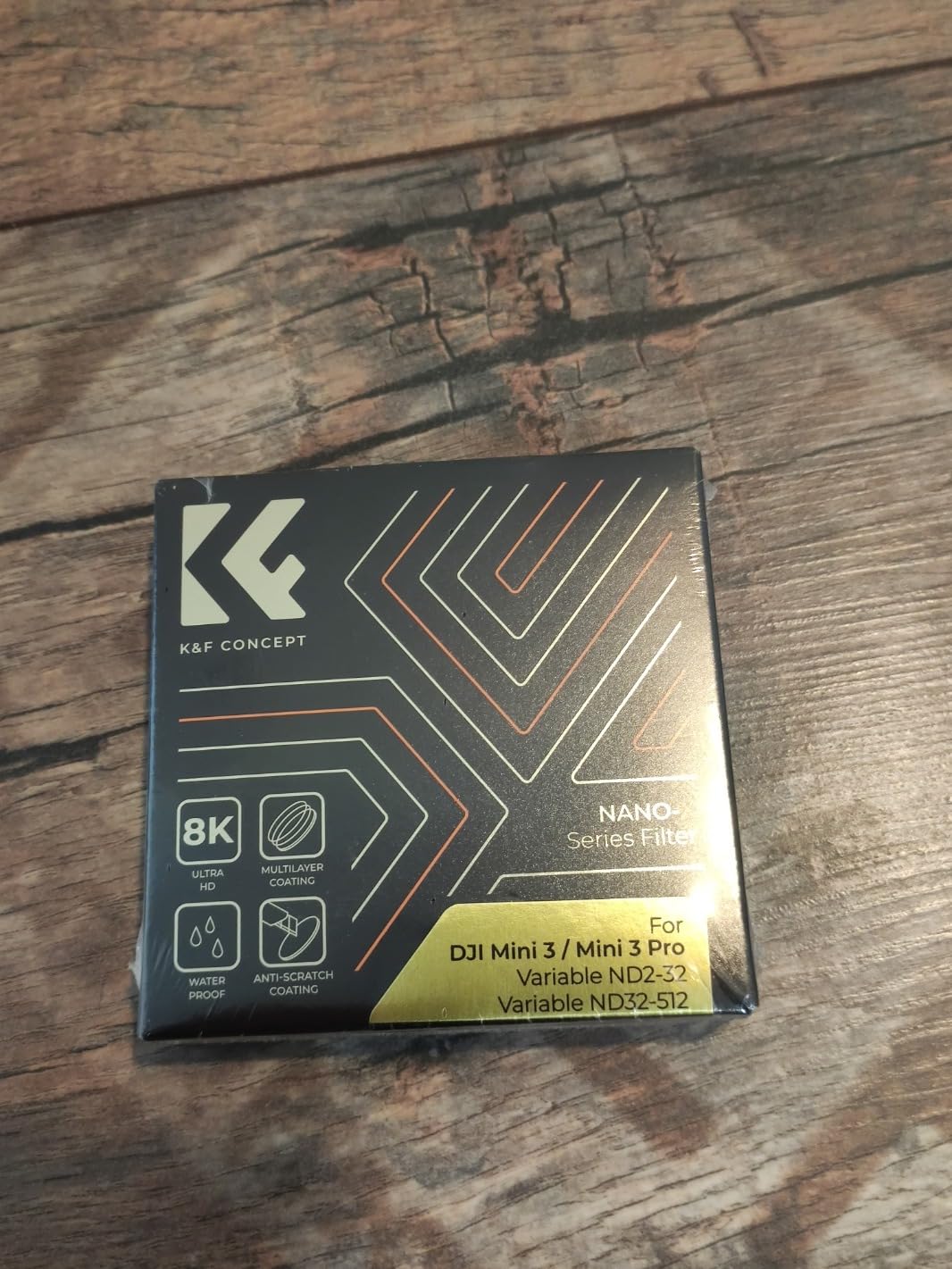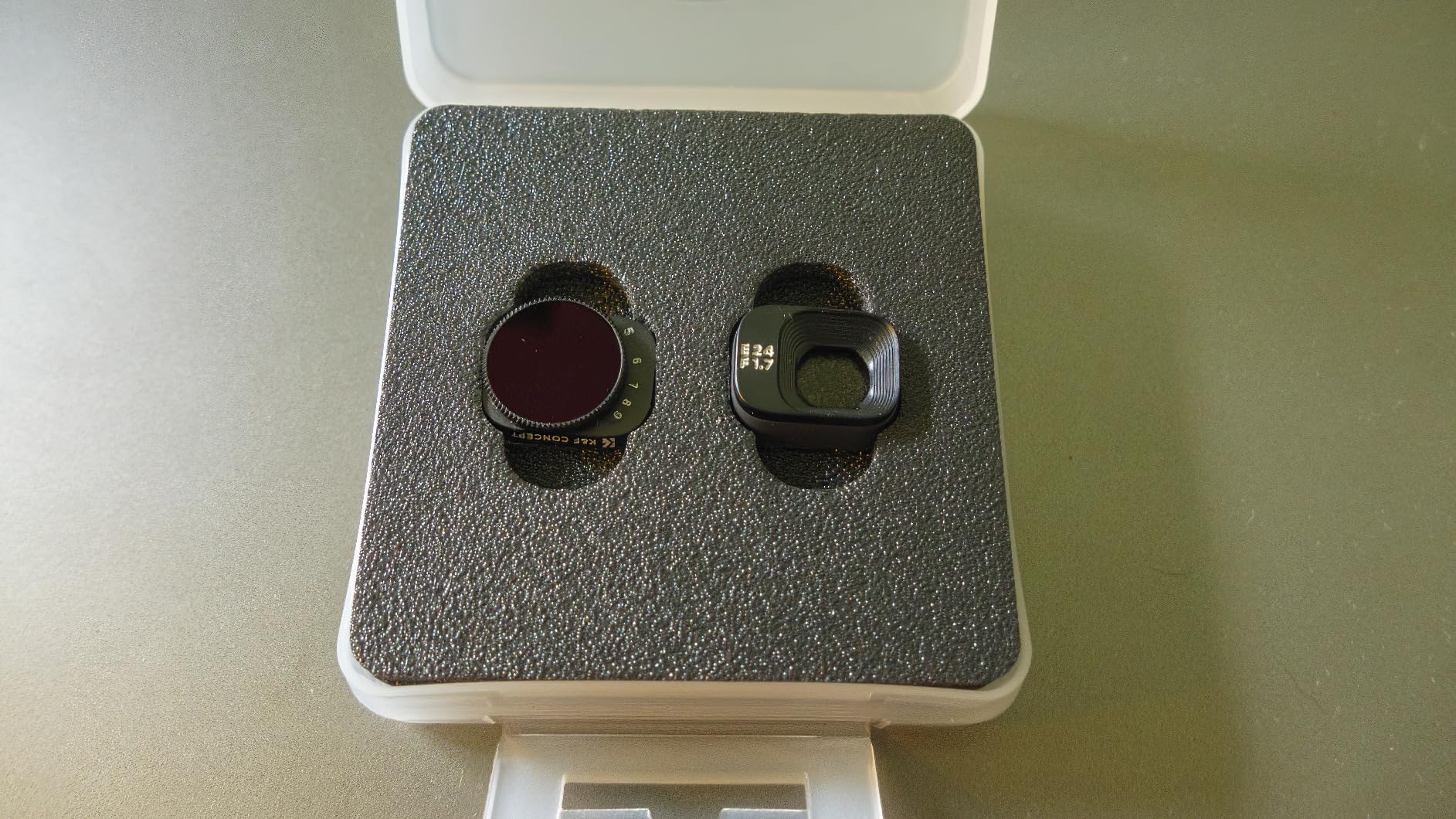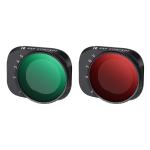
DJI Drone Filter Mini 3 Pro HD Filter 5pcs Set (UV + ND8 / PL + ND16 / PL + ND32 / PL + ND64 / PL) with 28 Layer Anti-reflection Green Coating, Waterproof and Scratchproof
SKU: SKU.1948
There are multiple advantages and disadvantages to having lens filters that provide a range of filtering.
Pros: The biggest advantage is convenience, because you don't have to carry around a bunch of different filters. Two filters give you coverage between 2 and 512, which is a huge range. Starting at 2, the filtering increments in doubles, so lens filter one gives you 2,4,8,16, and 32. Lens filter 2 gives you stops 32, 64, 128 and 512. This is a HUGE range, and you'd need 10 separate filters to duplicate this functionality.
Another advantage is if you're recording in weather conditions that change rapidly. In that situation you'd just need to land the drone, quickly dial in the new setting, and take off again without having to mess with changing filters.
Cons: There are usually optical tradeoffs whenever you have a variable lens filter as opposed to a single-stop filter. I compared the variable filter at various settings that matched single-stop filters I own (32, 64, 128). The variable filters are noticeable darker than the standalone filters. To me this indicates that calibration could be off, or maybe it's just the price you pay for variability. So for optimal recording, you'd want to know you had the right filter for the current conditions rather than having a filter that could be giving you a bit more filtering than you want.
On a less serious note, there's a reason that major lens filter makers don't typically offer a bunch of single-stop filters, especially in the smaller sizes. It's because the difference between a 2 and 4-stop filter or 4 to 8-stop filter will be very slight, possibly not even noticeable. Honestly, just looking at weather conditions, I don't know if I'd be able to accurately determine whether the conditions called for a 4, 8 or 16-stop filter. This is why filter kits typically jump from 32 to 64 to 128 etc.
In the end, you need to determine if the convenience of having two filters that give you 9 different stops (the 32-stop filter is duplicated) is important. Personally, it's a little too fine-tuned for me, and I'd probably wind up fiddling with the filters trying to determine the correct setting rather than concentrating on recording. For about the same price you could get a set of six separate filters that will more than cover you in all the conditions you're likely to be flying and recording in. You also have to ask whether the weather will be changing enough to justify a filter change. There are definitely times when it can cloud up quickly or a storm can blow in, but in these conditions I'd be thinking about bringing in the drone instead of continuing to record.
Pros: The biggest advantage is convenience, because you don't have to carry around a bunch of different filters. Two filters give you coverage between 2 and 512, which is a huge range. Starting at 2, the filtering increments in doubles, so lens filter one gives you 2,4,8,16, and 32. Lens filter 2 gives you stops 32, 64, 128 and 512. This is a HUGE range, and you'd need 10 separate filters to duplicate this functionality.
Another advantage is if you're recording in weather conditions that change rapidly. In that situation you'd just need to land the drone, quickly dial in the new setting, and take off again without having to mess with changing filters.
Cons: There are usually optical tradeoffs whenever you have a variable lens filter as opposed to a single-stop filter. I compared the variable filter at various settings that matched single-stop filters I own (32, 64, 128). The variable filters are noticeable darker than the standalone filters. To me this indicates that calibration could be off, or maybe it's just the price you pay for variability. So for optimal recording, you'd want to know you had the right filter for the current conditions rather than having a filter that could be giving you a bit more filtering than you want.
On a less serious note, there's a reason that major lens filter makers don't typically offer a bunch of single-stop filters, especially in the smaller sizes. It's because the difference between a 2 and 4-stop filter or 4 to 8-stop filter will be very slight, possibly not even noticeable. Honestly, just looking at weather conditions, I don't know if I'd be able to accurately determine whether the conditions called for a 4, 8 or 16-stop filter. This is why filter kits typically jump from 32 to 64 to 128 etc.
In the end, you need to determine if the convenience of having two filters that give you 9 different stops (the 32-stop filter is duplicated) is important. Personally, it's a little too fine-tuned for me, and I'd probably wind up fiddling with the filters trying to determine the correct setting rather than concentrating on recording. For about the same price you could get a set of six separate filters that will more than cover you in all the conditions you're likely to be flying and recording in. You also have to ask whether the weather will be changing enough to justify a filter change. There are definitely times when it can cloud up quickly or a storm can blow in, but in these conditions I'd be thinking about bringing in the drone instead of continuing to record.
17/06/2024
Having an adjustable filter instead of a complete set is certainly advantageous. It adapts perfectly to the cam, the adjustment is fast and totally chromatically neutral. Very light, they do not weigh down the gimbal at all.
Recommended product!
Recommended product!
16/06/2024
Got this for my mini 3 pro I just purchased. The ND filter works as stated and it’s very easy to use. Having this variable ND, I no longer need to carry 5 different ND filters
15/06/2024
Good quality ND filters fit easily and work even in vertical shooting.
Not very good at taking pictures and is hard to adjust compared with the ND standard fixed value filter.
Not very good at taking pictures and is hard to adjust compared with the ND standard fixed value filter.
14/06/2024
These two variable filters from K&F are an excellent alternative to the filter sets from other brands here on Amazon. For their problems with color shifts, enter the following search terms: “Mini 3 Pro ND Filters, Which Inexpensive Filter is Best?”
Normally, the ND2-ND32 is sufficient even in strong sun and there is no need to change the filter! You test shortly before the flight and set the appropriate value by ring marking. The adjustment is freely circumferential without stopping or snapping. The effect of increasing neutral density is achieved here by twisting two polarizing filters located one above the other.
Perfect fit: Both filters are very easy to attach to the lens, snap into place and hold tight!
White balance: I did not notice any significant differences in the white balance value between the individual ND levels. The color chart was photographed in each case by Datacolor.
Color behavior: K&F's promise that there are no color shifts was also kept. This was also checked in Lightroom Classic. Other filters cannot keep up with this and you may have to create and apply luts with appropriate color corrections using the Datacolor Color Charts or Spyder Checkr.
Sharpness and vignetting: The image remains absolutely sharp in comparison without the filter and vignetting is not visible.
Light reflection behavior: In backlight, no disturbing reflections were visible. The multi-coating does a very good job here.
Autofocus: The autofocus works well from a distance of 1m, even with a higher ND value. At a very short distance, I had slight problems taking pictures of the color chart from ND 32 and the focus was set too far back by the camera.
Weight: The filter weighs 1.5g and replaces the camera's lens protector, which weighs 0.7g. The drone therefore weighs 0.8 g more with the filter and therefore remains safely in the range of under 250 g total weight and can continue to be used without a drone license.
Storage box: Here too, K&F stands out from some other suppliers, because the original cover fits completely into the small plastic storage box from height and is therefore loss-proof.
Conclusion: With just a single, adjustable filter that can remain on the camera, you get significantly better video recordings with the 180° shutter rule, which look more cinematic. The overall picture is improved in terms of dynamics. The 32-512 ND filter is particularly interesting for photography when it comes to longer exposure times.
Normally, the ND2-ND32 is sufficient even in strong sun and there is no need to change the filter! You test shortly before the flight and set the appropriate value by ring marking. The adjustment is freely circumferential without stopping or snapping. The effect of increasing neutral density is achieved here by twisting two polarizing filters located one above the other.
Perfect fit: Both filters are very easy to attach to the lens, snap into place and hold tight!
White balance: I did not notice any significant differences in the white balance value between the individual ND levels. The color chart was photographed in each case by Datacolor.
Color behavior: K&F's promise that there are no color shifts was also kept. This was also checked in Lightroom Classic. Other filters cannot keep up with this and you may have to create and apply luts with appropriate color corrections using the Datacolor Color Charts or Spyder Checkr.
Sharpness and vignetting: The image remains absolutely sharp in comparison without the filter and vignetting is not visible.
Light reflection behavior: In backlight, no disturbing reflections were visible. The multi-coating does a very good job here.
Autofocus: The autofocus works well from a distance of 1m, even with a higher ND value. At a very short distance, I had slight problems taking pictures of the color chart from ND 32 and the focus was set too far back by the camera.
Weight: The filter weighs 1.5g and replaces the camera's lens protector, which weighs 0.7g. The drone therefore weighs 0.8 g more with the filter and therefore remains safely in the range of under 250 g total weight and can continue to be used without a drone license.
Storage box: Here too, K&F stands out from some other suppliers, because the original cover fits completely into the small plastic storage box from height and is therefore loss-proof.
Conclusion: With just a single, adjustable filter that can remain on the camera, you get significantly better video recordings with the 180° shutter rule, which look more cinematic. The overall picture is improved in terms of dynamics. The 32-512 ND filter is particularly interesting for photography when it comes to longer exposure times.
13/06/2024
I recently purchased the K&F ND filter for my Mini 3 Pro and I couldn't be happier with my purchase. I had been looking for a high-quality ND filter for my drone for a while, and I'm so glad I came across K&F's products.
First of all, the build quality of these filters is excellent. They're made with high-quality materials and feel very sturdy and well-made.
The filter also come with a carrying case which makes it easy to transport them without worrying about damage.
Overall, I'm really impressed with this ND filter and would highly recommend them to anyone looking for a high-quality filter at an affordable price. They're a great investment.
First of all, the build quality of these filters is excellent. They're made with high-quality materials and feel very sturdy and well-made.
The filter also come with a carrying case which makes it easy to transport them without worrying about damage.
Overall, I'm really impressed with this ND filter and would highly recommend them to anyone looking for a high-quality filter at an affordable price. They're a great investment.
12/06/2024
Very well done and easy to use. Perfect for my use and it looks good also on my mini 3Pro
11/06/2024
Purchased this as I didn’t want to purchase others types that has 10 different ND
This way you can keep it on and if you need to adjust just bring the drone down turn it to get more or less ND and send it back up
No idea why those other big name ND filters not come up with this idea
Pros
- Lightweight so no issues with the gimbal in flight.
- Great colour with minimum vignette.
- super for day time laps
Only negative I can think is I wish it was made out of metal rather than plastic.
Highly recommend over the rest overpriced ND on Amazon.
This way you can keep it on and if you need to adjust just bring the drone down turn it to get more or less ND and send it back up
No idea why those other big name ND filters not come up with this idea
Pros
- Lightweight so no issues with the gimbal in flight.
- Great colour with minimum vignette.
- super for day time laps
Only negative I can think is I wish it was made out of metal rather than plastic.
Highly recommend over the rest overpriced ND on Amazon.
10/06/2024
I am a fairly new drone pilot. Went out and got a bunch of filters. Then I come across these. They replace nearly all the filters I have except a CPL filter which is fine, as these replace tons of filters with their adjustable steps to filter out bright light or lower light. It's great not having to land my drone, take the filter off, fiddle with the others and install, take back off. Now I can simply land and adjust the ring on the outer of the filter. Makes it so much more convenient. Materials feel solid, doesn't seem to scratch easy as I've already dropped one on the ground. No visible damage. Highly recommend grabbing some of these if you tend to like to adjust your filters out in the field.
08/06/2024


